Today we have 4 portraits of a great horned owl.
Unfortunately it will also be the last time I post pictures of owls taken at night with a flash. I recently met with a professional photographer who made me aware of the unethical aspect of that technique when it comes to owls. Her admonition led me to research this issue, and I found a lot of articles. The lowdown is that there is definitely a risk of temporarily impairing the owl night vision because it is extremely sensitive. This could result in negative consequences for the owl, such as missing a meal due to the inability to catch a prey or, even worse, getting hurt by hitting an obstacle while flying away from my flash. I can’t stand the idea of hurting animals, so, that’s it for the owls at night.
These pictures were taken 2 months ago, so long before I became aware of this issue.
Now, as usual, I would like to share a few interesting facts about this bird.
Obviously, being an owl, it hunts at night, primarily looking for rabbits, hare, rats, and mice. But, it will also eat other animals it can get its claws into, such as snakes, frogs, and even, other birds. They will even attack dangerous animals, such as skunks and porcupines, sometimes resulting in their losing the battle. For instance, owls have been found blinded by musk sprayed on them by skunks.
Again, the owl has probably the best night vision of all the animals on Earth. One interesting aspect of the owl’s eyes, besides their very high sensitivity, is that they are face forward, unlike most birds. This gives the owl an excellent binocular angle, which is what you need for three dimensional perception. It allows this bird to be very accurate in judging the location of a potential prey.
The average lifespan of the great horned owl in the wild is 13 years, but they can live as long as 50 years in captivity.
Their talon is so strong that it can take an effort equivalent to 28 pounds to pry it open. That fact is stated here. If true, it tells you one thing: it’s very unlikely that a prey will escape once caught.
The great horned owl has ear tufts which, long ago, have been misnamed “horns. From all the articles I have read, the consensus is that we don’t know what their purpose might be. The only thing which experts agree on is that they don’t have any effect on hearing. And their hearing is 10 times better than ours.
This is the very owl whose famous song “who-hoo who-hoo” you will probably have heard many times if you take walks at night, and live not too much in the center of a city.
Unfortunately this beautiful bird dies often due to man’s activities. A lot of these birds are found shot, hit by a car, electrocuted by power lines, and poisoned by rats who had ingested “pest control” poison.
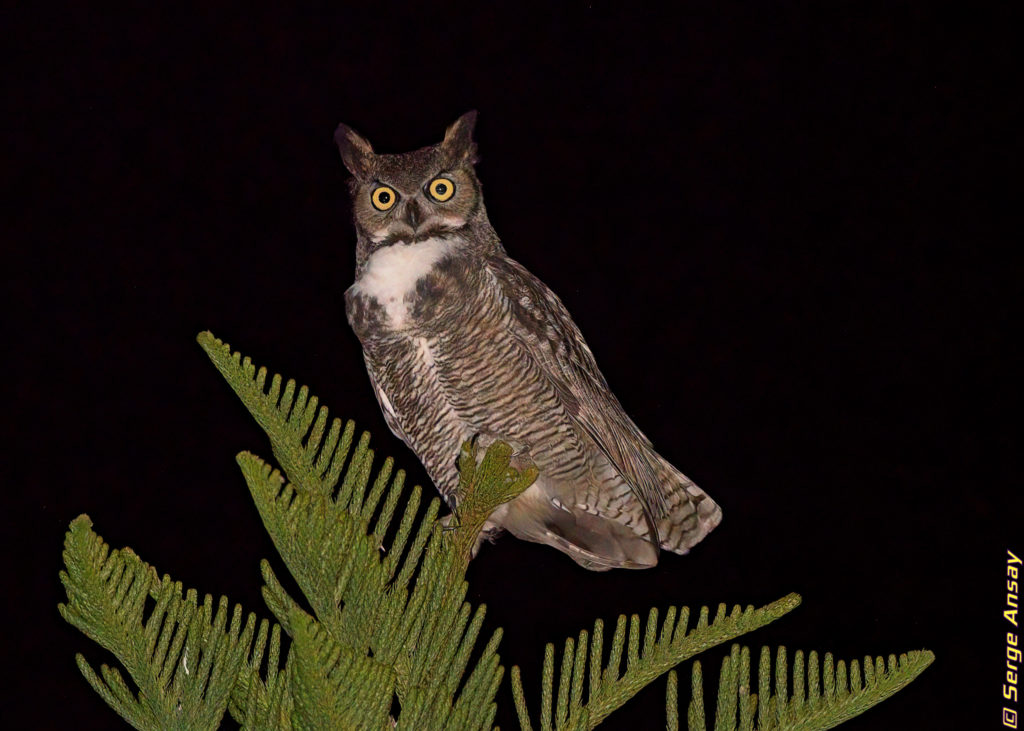
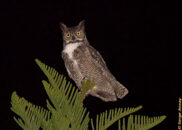
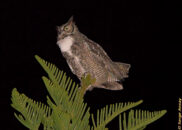
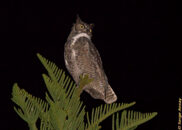
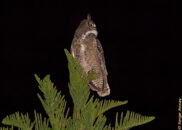
Photo’s look amazing Serge.
Thank you so much for the compliment Amos. I am very happy to hear that you like them.
They are the result of quite a bit of work.
Great photos Serge! I was thinking what about a flash that is beyond the range of what they can see? Like an IR flash (if one even exists). But you would have to know their visual range….
Thank you Michael.
Well yes, there maybe a way similar to infrared but easier to work with. I read an article where the author was suggesting working only with red light because that is much less likely to affect their night vision. So I could add a red filter to both my flashlight and the photo flash. But, of course, that would mean red monochrome pictures, which I would have to convert to black and white.